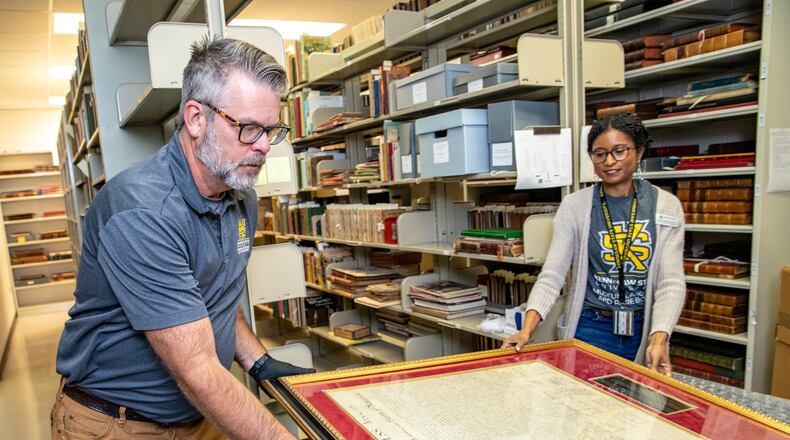Pressed behind the glass of an ornate gold frame, the familiar words flow across the delicate paper.
“We hold these truths to be self-evident, that all men are created equal,” it reads.
Here, in the backroom stacks of a Kennesaw State University library, is history. The rare 1843 copy of the Declaration of Independence is one of the most notable pieces in the school’s Bentley Rare Book Museum.
As the collection’s curator, JoyEllen Williams’ job is to preserve and to provide access to more than 10,000 rare books and manuscripts, including this facsimile of the United States’ founding document that announced the new nation’s freedom from British rule on July 4, 1776.
“It’s something that every citizen can connect to,” Williams said. “This is definitely a piece that generates awe.”
Credit: Jenni Girtman
Credit: Jenni Girtman
But the copy, valued at $15,000 to $25,000, is in need of conservation. In recent years, the document has been in storage, only coming out once or twice a year for special programs.
In the campus quiet of a June morning, Williams points to small tears and dark spots that mottle the semi-transparent paper. The piece has been framed, tucked behind a velvety red mat, since before the university purchased it from an Atlanta rare book dealer more than two decades ago.
Williams and the university’s exhibit designer, Tony Howell, said the materials are likely acidic, which can cause the document to slowly deteriorate.
A recent online campaign raised more than $6,000 in donations to pay for conservation work. The museum has funds to pay for routine preservation needs, but the university said some projects require extra support.
Experts at the Georgia Archives in Morrow will inspect the document and mend and stabilize the paper. The Georgia Archives, like Kennesaw State, is part of the University System of Georgia. Its staff collects and preserves the state’s historical documents.
The project is expected to start later this summer and could take months to complete.
Credit: Jenni Girtman
Credit: Jenni Girtman
When the Declaration of Independence returns to Kennesaw, Williams plans to find new ways to showcase it and make it available to students, researchers and the community.
“All of our items in here are special in some way, but we do have some very high-value items that people will want to use all the time,” she said. “This is one of those items.”
Williams said the Kennesaw piece is among a couple of hundred remaining copies of the Declaration of Independence that were printed by Peter Force, a publisher and historian.
Force had the replicas made and then folded up and tucked inside a series of dense volumes titled “American Archives.” The books exhaustively documented discussions that took place during the nation’s development, such as a day-by-day accounting of the proceedings of the South Carolina’s general assembly.
Credit: Jenni Girtman
Credit: Jenni Girtman
What makes these copies special is that they were created using a copperplate engraving of the original Declaration of Independence, making them look as close as possible to the real thing. In the early 1820s, Secretary of State John Quincy Adams asked William J. Stone to engrave a facsimile of the declaration, which was already fading.
Stone’s copperplate was used to create 200 copies of the declaration printed on animal skin, which were distributed to important figures and official archives. The Kennesaw copy, using that same copperplate, came about 20 years later, Williams said.
The original Declaration of Independence is on display at the National Archives Museum in Washington, D.C., along with the Constitution and the Bill of Rights.
“John Quincy Adams wanted as close as possible to a replica because the declaration, the original, was really starting to show signs of wear by the 1820s,” Williams said. “I’m so glad that he did that, especially considering 90% of the original we can’t read anymore and can’t really see anymore.”
Bentley Rare Book Museum at Kennesaw State University
The collection contains more than 10,000 books and manuscripts, including an 1843 copy of the Declaration of Independence. Other highlights include:
- A Lunar Bible, which in 1971 flew to the moon on the Apollo 14 mission
- Fourth Folio of Shakespeare that dates to 1685
- Two 4,000-year-old cuneiform tablets
- 1641 copy of Galileo’s “Systema Cosmicum”
- Illuminated manuscript leaves from the Middle Ages
- Signed first-edition 1963 copy of “Strength to Love” by Rev. Martin Luther King Jr., which he inscribed to his mother.
Source: Kennesaw State University
About the Author








